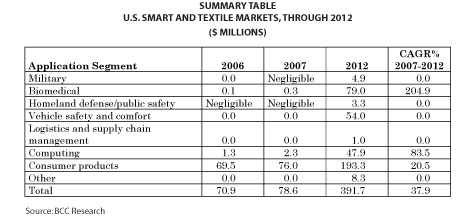|
Mainland High School
Suitable for a Disaster: ISTF 08-1835 |
|||||||||||||||||||||||||
|
Home
Introduction Contest Components One Two  Product Product
Three Fabrics History of Fabrics Smart Fabric Projects Sensors Nano Sensors Power Production Communication Cell Phones 3G Phones Data Transfer Helikites Interoperability Microwaves Relief Agencies Telecommunication Project Assessment Team |
Component Three
Provide a forecast of what the workforce demand
would be over a five-year period to produce and market your team's technical application
or process. Include the impact such production would have on the marketplace.
The manufacture of our product, which integrates wireless sensors and communications
devices into "smart clothing," will require a variety of workforce skills. These
skills include electrical and electronic equipment assembly, electrical and electronic
engineering, computer hardware engineering, computer software applications engineering,
and computer systems software engineering.
The Monthly Labor Review for November 2005 from the Bureau of Labor Statistics states jobs in these areas like computer system design are among the fastest growing jobs in the United States. According to Al Dill, President of the Blackfox Training Institute, these jobs would not likely be outsourced, because of their complexity and need for skilled workers. The Bureau of Labor Statistics states in their Career Guide to Industries, that there will be demand for research and development as well as for production workers. This means there will be an increase in demand for these occupational areas at all levels, from technical education through two and four year degrees, to graduate degree programs. While certain parts of the communication market are be on the decline, new smart phones and wireless networks with high data flow ability reamin strong. Wireless communication is a main factor in the growth of the telecommunications industry. Wireless service already allows connectivity between a diverse group of devices such as, phones, computers, and even television. Our project's suit will open yet another telecommunications application. The use of smart materials, such as those in our suit, is expected to increase as research makes them more accessible. These smart materials include biological sensors and piezoelectric power sources. Demand is expected to increase for both products as improvements are made and more suits are constructed. As more development occurs, the economic effects of Smart clothes will increase. While smart textiles will be applied more often to consumer products and biomedical industries, significant use in homeland defense and public safety is expected by 2012. Our suit would directly impact public safety, and would stimulate the demand and scope of smart textiles for military and biomedical industries.
Give two examples of undergraduate or graduate
degree programs in science or engineering that directly relate to your team's NCT
technical application. For each program, be sure to include the following:
Develop an idea for a new science and/or engineering degree program that might emerge given the advancements in scientific knowledge that the team has identified. Provide a title and 100-word description of this new degree program.
Students entering our graduate degree program, Mobile Communication & Network Engineering,
are expected to take undergraduate courses in electrical engineering to develop
a fundamental understanding of the theory and practices in the design, programming,
and management of remote communication networks. Such jobs require a high degree
of reliability in extreme or hazardous environments. Courses focus on wireless network
systems, their security, hardware, software and improvements.
Students are expected to complete the following courses along with an internship to ensure that they gain the field experience necessary to design equipment that is effective, reliable and relevant in disaster situations.
In emails dated 24 February 2009, Mr. Kister stated that:
His company has grown dramatically over the last 5 years. In the last 12 months, we have increased our staff 35-40%. The four basic functions
that Skycasters perform are: installation coordination, billing, technical support,
and engineering. The first three really do not require any specialized skill, just
a brain and the willingness to learn. Installers are required to be bonded, have two-way VSAT certification, people-skills, and keep a neat work area.
However to be an engineer at Skycasters you must have have a lot of experience. For example the senior RF engineer at Skycasters
has spent 30+ years in the Army, which solidifies his experience in the field. The
R&D work done at Skycasters is mostly "mechanical engineering". They make trailers,
flyaways, fuel cell powered systems, etc. that all become massive integration projects
of various pieces of off the shelf technology.
Advanced Imaging- Smart Pants http://www.advancedimagingpro.com/article/article.jsp?siteSection=38&id=3266&pageNum=1 BCC Research- Advanced Materials http://www.bccresearch.com/report/AVM023C.html Bradely Department of Electrical & Computer Engineering- E Textiles http://www.ccm.ece.vt.edu/etextiles/ BSCPE 4-Year Tentative Curriculum Class of 2009 http://www.ece.vt.edu/ugrad/curriculum/09/cpe09.html BSEE 4-Year Curriculum Class of 2009 http://www.ece.vt.edu/ugrad/curriculum/09/ee09.html Component One http://istf.acmtmhs.org./istf2009/one.asp#MURI Cornell News- Cornell student develops 'smart' jacket that warms, lights up at night and even monitors heart rate http://www.news.cornell.edu/releases/Dec02/smart.jacket.ssl.html Cornell News- Cornell joins prestigious research consortium for textiles and apparel following award of national research accolade http://www.news.cornell.edu/releases/March02/textile.consort.ssl.html Cornell student develops 'smart' jacket that warms, lights up at night and even monitors heart rate http://www.news.cornell.edu/releases/Dec02/smart.jacket.ssl.html Cornell University College of Human Ecology-Fiber Science & Apparel Design Home http://www.human.cornell.edu/che/fsad/index.cfm Cornell University College of Human Ecology- Hinestroza Research Group Textile Nanotechnology Laboratory http://nanotextiles.human.cornell.edu/index.htm Daily Wireless- Mobile Ad Projections http://www.dailywireless.org/2008/05/05/7733/ Degree in Emergency Services Management http://scs.richmond.edu/emergency/ ECE Undergraduate Programs http://www.ece.vt.edu/ugrad/courses.html Fiber Science & Apparel Design 2008-2009 http://www.human.cornell.edu/che/Academics/Undergraduate/Student_Services/Registrar/Degree_Progress/upload/FSADIII_08-09.pdf High Beam Research- Department is now Fiber Science & Apparel Design http://www.highbeam.com/doc/1G1-173190049.html Machine Design- Something up the sleeve http://machinedesign.com/article/something-up-the-sleeve-0928 Nanofabrics -Smart Clothes Repel Germs, Allergens & Pollution http://www.dailygalaxy.com/my_weblog/2007/10/smart-clothing-.html Smart Pants- Computer Engineers Develop Clothes that Sense and Interpret Movements http://www.sciencedaily.com/videos/2006/0402-smart_pants.htm Textiles Nanotechnology Laboratory http://www.people.cornell.edu/pages/jh433/index.htm The Daily Galaxy- Nanofabrics- Start Clothes Repel Germs, Allergens & Pollution http://www.dailygalaxy.com/my_weblog/2007/10/smart-clothing-.html The Washington Post-'E-Textiles' May Give 'Custom Tailoring' New Meaning http://www.washingtonpost.com/wp-dyn/content/article/2007/10/06/AR2007100601097.html Think- Smart Cloths http://thinkmagazine.blogspot.com/2008/08/smart-clothes.html University of Richmond- Emergency http://scs.richmond.edu/emergency/ Virginia Tech- E-textiles http://www.research.vt.edu/resmag/2007summer/textiles.html |
||||||||||||||||||||||||



 the
URL address of the institution,
the
URL address of the institution,







